2,3-Pentanedione
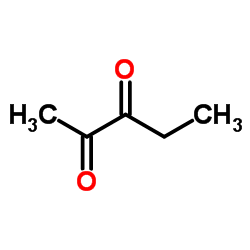
2,3-Pentanedione structure
|
Common Name | 2,3-Pentanedione | ||
|---|---|---|---|---|
| CAS Number | 600-14-6 | Molecular Weight | 100.116 | |
| Density | 1.0±0.1 g/cm3 | Boiling Point | 108.0±0.0 °C at 760 mmHg | |
| Molecular Formula | C5H8O2 | Melting Point | -52 °C | |
| MSDS | Chinese USA | Flash Point | 18.9±0.0 °C | |
| Symbol |


GHS02, GHS07 |
Signal Word | Danger | |
Use of 2,3-Pentanedione2,3-Pentanedione is a common constituent of synthetic flavorings and is used to impart a butter, strawberry, caramel, fruit, rum, or cheese flavor in beverages, ice cream, candy, baked goods, gelatins, and puddings. 2,3-Pentanedione also occurs naturally as a fermentation product in beer, wine, and yogurt and is releasedduring roasting of coffee beans[1]. |
| Name | pentane-2,3-dione |
|---|---|
| Synonym | More Synonyms |
| Description | 2,3-Pentanedione is a common constituent of synthetic flavorings and is used to impart a butter, strawberry, caramel, fruit, rum, or cheese flavor in beverages, ice cream, candy, baked goods, gelatins, and puddings. 2,3-Pentanedione also occurs naturally as a fermentation product in beer, wine, and yogurt and is releasedduring roasting of coffee beans[1]. |
|---|---|
| Related Catalog | |
| References |
| Density | 1.0±0.1 g/cm3 |
|---|---|
| Boiling Point | 108.0±0.0 °C at 760 mmHg |
| Melting Point | -52 °C |
| Molecular Formula | C5H8O2 |
| Molecular Weight | 100.116 |
| Flash Point | 18.9±0.0 °C |
| Exact Mass | 100.052429 |
| PSA | 34.14000 |
| LogP | -0.80 |
| Vapour Pressure | 26.4±0.2 mmHg at 25°C |
| Index of Refraction | 1.395 |
| Storage condition | 2-8°C |
| Stability | Stable. Highly flammable - store cool. Incompatible with strong oxidizing agents, reducing agents, strong bases. |
| Water Solubility | 60 g/L (15 ºC) |
Synonym:Acetylpropiony Section 2 - COMPOSITION, INFORMATION ON INGREDIENTS
Risk Phrases: 11 Section 3 - HAZARDS IDENTIFICATION EMERGENCY OVERVIEW
Highly flammable. Potential Health Effects Eye: May cause eye irritation and possible burns. Skin: Causes skin irritation and possible burns. Ingestion: May cause digestive tract disturbances. Inhalation: May cause respiratory tract irritation. Vapors may cause dizziness or suffocation. Chronic: No information found. Section 4 - FIRST AID MEASURES Eyes: Flush eyes with plenty of water for at least 15 minutes, occasionally lifting the upper and lower eyelids. Get medical aid immediately. Skin: Get medical aid. Flush skin with plenty of water for at least 15 minutes while removing contaminated clothing and shoes. Remove contaminated clothing and shoes. Ingestion: If victim is conscious and alert, give 2-4 cupfuls of milk or water. Never give anything by mouth to an unconscious person. Get medical aid immediately. Inhalation: Remove from exposure and move to fresh air immediately. If not breathing, give artificial respiration. If breathing is difficult, give oxygen. Get medical aid. Notes to Physician: Section 5 - FIRE FIGHTING MEASURES General Information: As in any fire, wear a self-contained breathing apparatus in pressure-demand, MSHA/NIOSH (approved or equivalent), and full protective gear. Vapors may form an explosive mixture with air. Vapors can travel to a source of ignition and flash back. During a fire, irritating and highly toxic gases may be generated by thermal decomposition or combustion. Will burn if involved in a fire. Use water spray to keep fire-exposed containers cool. Containers may explode in the heat of a fire. Flammable liquid and vapor. Vapors may be heavier than air. They can spread along the ground and collect in low or confined areas. Extinguishing Media: For small fires, use dry chemical, carbon dioxide, water spray or alcohol-resistant foam. For large fires, use water spray, fog, or alcohol-resistant foam. Water may be ineffective. Do NOT use straight streams of water. Cool containers with flooding quantities of water until well after fire is out. Section 6 - ACCIDENTAL RELEASE MEASURES General Information: Use proper personal protective equipment as indicated in Section 8. Spills/Leaks: Absorb spill with inert material (e.g. vermiculite, sand or earth), then place in suitable container. Avoid runoff into storm sewers and ditches which lead to waterways. Clean up spills immediately, observing precautions in the Protective Equipment section. Remove all sources of ignition. Use a spark-proof tool. Provide ventilation. A vapor suppressing foam may be used to reduce vapors. Water spray may reduce vapor but may not prevent ignition in closed spaces. Section 7 - HANDLING and STORAGE Handling: Wash thoroughly after handling. Use with adequate ventilation. Ground and bond containers when transferring material. Use spark-proof tools and explosion proof equipment. Avoid contact with eyes, skin, and clothing. Empty containers retain product residue, (liquid and/or vapor), and can be dangerous. Keep away from heat, sparks and flame. Avoid ingestion and inhalation. Do not pressurize, cut, weld, braze, solder, drill, grind, or expose empty containers to heat, sparks or open flames. Storage: Keep away from heat, sparks, and flame. Keep away from sources of ignition. Store in a cool, dry, well-ventilated area away from incompatible substances. Refrigerator/flammables. Keep containers tightly closed. Section 8 - EXPOSURE CONTROLS, PERSONAL PROTECTION Engineering Controls: Use adequate ventilation to keep airborne concentrations low. Exposure Limits CAS# 600-14-6: Personal Protective Equipment Eyes: Wear appropriate protective eyeglasses or chemical safety goggles as described by OSHA's eye and face protection regulations in 29 CFR 1910.133 or European Standard EN166. Skin: Wear appropriate protective gloves to prevent skin exposure. Clothing: Wear appropriate protective clothing to prevent skin exposure. Respirators: Follow the OSHA respirator regulations found in 29 CFR 1910.134 or European Standard EN 149. Use a NIOSH/MSHA or European Standard EN 149 approved respirator if exposure limits are exceeded or if irritation or other symptoms are experienced. Section 9 - PHYSICAL AND CHEMICAL PROPERTIES Physical State: Liquid Color: clear yellow Odor: None reported. pH: Not available. Vapor Pressure: Not available. Viscosity: Not available. Boiling Point: 110.0 - 112.0 deg C Freezing/Melting Point: -52 deg C Autoignition Temperature: Not available. Flash Point: 18 deg C ( 64.40 deg F) Explosion Limits, lower: Not available. Explosion Limits, upper: Not available. Decomposition Temperature: Solubility in water: partially soluble Specific Gravity/Density: .9570g/cm3 Molecular Formula: C5H8O2 Molecular Weight: 100.12 Section 10 - STABILITY AND REACTIVITY Chemical Stability: Stable under normal temperatures and pressures. Conditions to Avoid: Incompatible materials, ignition sources, excess heat, strong oxidants. Incompatibilities with Other Materials: Strong oxidizing agents. Hazardous Decomposition Products: Carbon monoxide, carbon dioxide, acrid smoke and fumes. Hazardous Polymerization: Has not been reported. Section 11 - TOXICOLOGICAL INFORMATION RTECS#: CAS# 600-14-6: SA1850000 LD50/LC50: CAS# 600-14-6: Draize test, rabbit, skin: 500 mg/24H Moderate; Oral, rat: LD50 = 3 gm/kg; Skin, rabbit: LD50 = >2500 mg/kg. Skin, Rabbitt:LD50 = >2500 Carcinogenicity: 2,3-Pentanedione - Not listed by ACGIH, IARC, or NTP. Other: See actual entry in RTECS for complete information. Section 12 - ECOLOGICAL INFORMATION Section 13 - DISPOSAL CONSIDERATIONS Dispose of in a manner consistent with federal, state, and local regulations. Section 14 - TRANSPORT INFORMATION IATA Shipping Name: FLAMMABLE LIQUID, N.O.S.* Hazard Class: 3 UN Number: 1993 Packing Group: II IMO Shipping Name: FLAMMABLE LIQUID, N.O.S. Hazard Class: 3.2 UN Number: 1993 Packing Group: II RID/ADR Shipping Name: FLAMMABLE LIQUID, N.O.S. Hazard Class: 3 UN Number: 1993 Packing group: II Section 15 - REGULATORY INFORMATION European/International Regulations European Labeling in Accordance with EC Directives Hazard Symbols: F Risk Phrases: R 11 Highly flammable. Safety Phrases: S 9 Keep container in a well-ventilated place. S 16 Keep away from sources of ignition - No smoking. S 33 Take precautionary measures against static discharges. S 50A Do not mix with acids. WGK (Water Danger/Protection) CAS# 600-14-6: 1 Canada CAS# 600-14-6 is listed on Canada's DSL List. CAS# 600-14-6 is not listed on Canada's Ingredient Disclosure List. US FEDERAL TSCA CAS# 600-14-6 is listed on the TSCA inventory. SECTION 16 - ADDITIONAL INFORMATION N/A |
CHEMICAL IDENTIFICATION
HEALTH HAZARD DATAACUTE TOXICITY DATA
|
| Symbol |


GHS02, GHS07 |
|---|---|
| Signal Word | Danger |
| Hazard Statements | H225-H315-H319-H335 |
| Precautionary Statements | P210-P261-P305 + P351 + P338 |
| Personal Protective Equipment | Eyeshields;Faceshields;full-face respirator (US);Gloves;multi-purpose combination respirator cartridge (US);type ABEK (EN14387) respirator filter |
| Hazard Codes | F:Flammable |
| Risk Phrases | R11;R36/37/38 |
| Safety Phrases | S16-S26-S36-S37/39 |
| RIDADR | UN 1224 3/PG 2 |
| WGK Germany | 1 |
| RTECS | SA1850000 |
| Packaging Group | II |
| Hazard Class | 3 |
| HS Code | 2914190090 |
| Precursor 7 | |
|---|---|
| DownStream 10 | |
| HS Code | 2914190090 |
|---|---|
| Summary | 2914190090 other acyclic ketones without other oxygen function。Supervision conditions:None。VAT:17.0%。Tax rebate rate:9.0%。MFN tariff:5.5%。General tariff:30.0% |
|
Olfactometry Profiles and Quantitation of Volatile Sulfur Compounds of Swiss Tilsit Cheeses.
J. Agric. Food Chem. 63 , 7511-21, (2015) To establish the odor profiles of three differently fabricated commercial Swiss Tilsit cheeses, analyses were conducted using headspace solid-phase microextraction gas chromatography-mass spectrometry... |
|
|
Method development by GC-ECD and HS-SPME-GC-MS for beer volatile analysis.
Food Chem. 167 , 71-7, (2014) Two methods for the extraction, identification and quantification of the highest occurrence and lowest perception threshold off-flavours in fifteen different samples of Brazilian Pilsner beers were de... |
|
|
Postmitotic diversification of olfactory neuron types is mediated by differential activities of the HMG-box transcription factor SOX-2.
EMBO J. 34 , 2574-89, (2015) Diversification of neuron classes is essential for functions of the olfactory system, but the underlying mechanisms that generate individual olfactory neuron types are only beginning to be understood.... |
| EINECS 209-984-8 |
| MFCD08443597 |
| 2,3-Pentadione |
| 2.6-Pentanedione |
| 2,3-PENTANEDITHIOL |
| 3,4-Pentanedione |
| ethyl methyl diketone |
| 2VV1 |
| PENTANDION-2,3 |
| Acethylpropionyl |
| pentanedione |
| 2.3-pentanedione |
| 2,3-pentandione |
| Acetylpropionyl |
| 2,3-Pentandion |
| 2,3-Pentanedione |
 CAS#:123-38-6
CAS#:123-38-6 CAS#:849585-22-4
CAS#:849585-22-4 CAS#:75-18-3
CAS#:75-18-3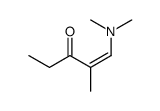 CAS#:81609-25-8
CAS#:81609-25-8 CAS#:110-00-9
CAS#:110-00-9 CAS#:108-24-7
CAS#:108-24-7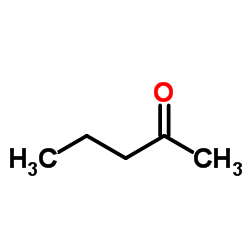 CAS#:107-87-9
CAS#:107-87-9![2-[(E)-[(2Z)-2-(diaminomethylidenehydrazinylidene)pentan-3-ylidene]amino]guanidine structure](https://image.chemsrc.com/caspic/295/106119-98-6.png) CAS#:106119-98-6
CAS#:106119-98-6 CAS#:32818-79-4
CAS#:32818-79-4 CAS#:540-88-5
CAS#:540-88-5 CAS#:107-71-1
CAS#:107-71-1 CAS#:20487-40-5
CAS#:20487-40-5 CAS#:14206-05-4
CAS#:14206-05-4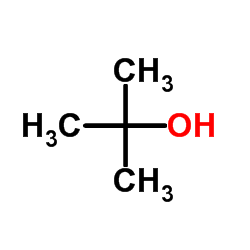 CAS#:75-65-0
CAS#:75-65-0![[(Z)-[(2E)-2-(carbamothioylhydrazinylidene)pentan-3-ylidene]amino]thiourea structure](https://image.chemsrc.com/caspic/301/18667-57-7.png) CAS#:18667-57-7
CAS#:18667-57-7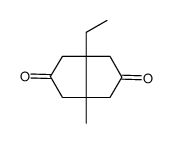 CAS#:191854-09-8
CAS#:191854-09-8 CAS#:67-51-6
CAS#:67-51-6
